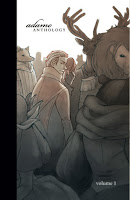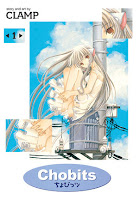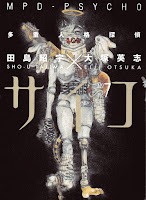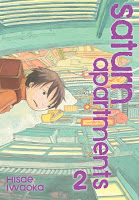My News and Reviews
Last week I posted two reviews, neither one of which were for manga. I reviewed Book Girl and the Famished Spirit, the second volume in Mizuki Nomura’s Book Girl light novel series. I didn’t enjoy it quite as well as the first volume, but I still love the series’ premise of a literature eating yōkai. I also reviewed Christopher Ross’ memoir/travelogue/biography thingy (it’s a little difficult to classify) Mishima’s Sword: Travels in Search of a Samurai Legend. It’s an interesting read and I’d recommended it to anyone interested in Yukio Mishima or in Japanese swords and swordsmanship.
The Fumi Yoshinaga Manga Moveable Feast starts today! This month the Feast will be co-hosted by Kristin Bomba of Comic Attack and Linda Yau of Animemiz’s Scribblings. Yoshinaga is one of the darlings of the manga blogging community so there should be plenty of great submissions. As for me, I’ll be reviewing the third volume of Ōoku: The Inner Chambers, which may possibly be my favorite Yoshinaga series. At least at the moment. If I had at all been paying attention, I would have also read a bunch of Yoshinaga manga for this post’s quick takes section. Anyway, that was my original intention. The Feast somehow snuck up on me this time around. My bad. So, I’ll all make sure to do it for next week’s quick takes instead.
Also of note: Experiments in Manga’s one-year anniversary is coming up in a few days!
Quick Takes
 Adamo Anthology, Volume 1: Strange Love by Various. 2010 saw the publication of several independent original-English boys’ love collections, Adamo Anthology among them. The first volume collects four stories and four pin-up illustrations with the theme of “strange love.” Each story has some sort of supernatural element or other oddity to the featured couple’s relationship—psychics and psychopaths, a kidnapped rookie cop, haunted guitars, a musician who’s shut himself away from the world. Each artist has a distinctive style and its nice to see the variety in the stories and illustrations. The pinups are fun, too. I haven’t heard anything about a second Adamo Anthology yet, but if there ever is one I’ll be picking it up.
Adamo Anthology, Volume 1: Strange Love by Various. 2010 saw the publication of several independent original-English boys’ love collections, Adamo Anthology among them. The first volume collects four stories and four pin-up illustrations with the theme of “strange love.” Each story has some sort of supernatural element or other oddity to the featured couple’s relationship—psychics and psychopaths, a kidnapped rookie cop, haunted guitars, a musician who’s shut himself away from the world. Each artist has a distinctive style and its nice to see the variety in the stories and illustrations. The pinups are fun, too. I haven’t heard anything about a second Adamo Anthology yet, but if there ever is one I’ll be picking it up.
 Chi’s Sweet Home, Volume 4-6 by Konami Kanata. I’ll admit it, I love Chi’s Sweet Home. Admittedly, I like cats and people who like cats are probably the people who will find this series most appealing. Kanata seems to have anthropomorphized Chi a bit more in these volumes than in the previous ones, but she is still primarily very cat like. I was already familiar with some of these chapters since they were the basis of some of the Chi’s Sweet Home: Chi’s New Address anime episodes, but they were still delightfully charming. I am impressed that Kanata has been able to come up with so many adventures for Chi without becoming too repetitive. Although, if you’ve read any of Chi’s Sweet Home, you pretty much know what to expect by now.
Chi’s Sweet Home, Volume 4-6 by Konami Kanata. I’ll admit it, I love Chi’s Sweet Home. Admittedly, I like cats and people who like cats are probably the people who will find this series most appealing. Kanata seems to have anthropomorphized Chi a bit more in these volumes than in the previous ones, but she is still primarily very cat like. I was already familiar with some of these chapters since they were the basis of some of the Chi’s Sweet Home: Chi’s New Address anime episodes, but they were still delightfully charming. I am impressed that Kanata has been able to come up with so many adventures for Chi without becoming too repetitive. Although, if you’ve read any of Chi’s Sweet Home, you pretty much know what to expect by now.
 Chobits, Omnibus 1-2 (equivalent to Volumes 1-8) by CLAMP. Chobits was my introduction to CLAMP and I’m quite fond of the series. Granted, I’m a sucker for android stories. To be honest, there’s a fair amount of pandering in Chobits, particularly early on in the series. The fanservice does show up throughout the series, though. To some extent, the fanservice actually serves to further the story as the characters struggle to understand concepts of love, desire, loneliness, and what it means to be human. I like Hideki, the protagonist of the series. As just about every character mentions (much to his dismay), he’s a good guy. Chobits has nice art, an engaging story, and likeable characters.
Chobits, Omnibus 1-2 (equivalent to Volumes 1-8) by CLAMP. Chobits was my introduction to CLAMP and I’m quite fond of the series. Granted, I’m a sucker for android stories. To be honest, there’s a fair amount of pandering in Chobits, particularly early on in the series. The fanservice does show up throughout the series, though. To some extent, the fanservice actually serves to further the story as the characters struggle to understand concepts of love, desire, loneliness, and what it means to be human. I like Hideki, the protagonist of the series. As just about every character mentions (much to his dismay), he’s a good guy. Chobits has nice art, an engaging story, and likeable characters.
 Color of Rage written by Kazuo Koike and illustrated by Seisaku Kano. Something just doesn’t sit right with me about Color of Rage. It’s as though a blaxploitation film has been crossed with a manga about feudal Japan. It’s not necessarily a bad combination, but Color of Rage just doesn’t quite pull it off. The characters frequently liken slavery in the United States to Japan’s caste system, but the comparison is oversimplified and therefore unconvincing. King, one of the escaped slaves, doesn’t really convince me, either. His motivations and actions seem inconsistent even though he is intended to be the more honorable of the two. Kano’s gekiga-style illustrations work well for the story, although the action sequences can be somewhat difficult to follow.
Color of Rage written by Kazuo Koike and illustrated by Seisaku Kano. Something just doesn’t sit right with me about Color of Rage. It’s as though a blaxploitation film has been crossed with a manga about feudal Japan. It’s not necessarily a bad combination, but Color of Rage just doesn’t quite pull it off. The characters frequently liken slavery in the United States to Japan’s caste system, but the comparison is oversimplified and therefore unconvincing. King, one of the escaped slaves, doesn’t really convince me, either. His motivations and actions seem inconsistent even though he is intended to be the more honorable of the two. Kano’s gekiga-style illustrations work well for the story, although the action sequences can be somewhat difficult to follow.
 Revolutionary Girl Utena: The Black Rose Saga directed by Kunihiko Ikuhara. The second of Nozomi’s Revolutionary Girl Utena box sets, The Black Rose Saga collects episodes thirteen through twenty-four of the series. This is my first time watching Revolutionary Girl Utena and I’m still loving it. Sure, the reuse of animation sequences is noticeable and the duels in The Black Rose Saga are somewhat repetitive because of it. Also, The Black Rose Saga introduces new characters and plot complications rather suddenly. But the psychological elements in the series are tremendous and frequently heartbreaking. The Ohtori Academy is one awfully strange place to go to school.
Revolutionary Girl Utena: The Black Rose Saga directed by Kunihiko Ikuhara. The second of Nozomi’s Revolutionary Girl Utena box sets, The Black Rose Saga collects episodes thirteen through twenty-four of the series. This is my first time watching Revolutionary Girl Utena and I’m still loving it. Sure, the reuse of animation sequences is noticeable and the duels in The Black Rose Saga are somewhat repetitive because of it. Also, The Black Rose Saga introduces new characters and plot complications rather suddenly. But the psychological elements in the series are tremendous and frequently heartbreaking. The Ohtori Academy is one awfully strange place to go to school.
 Samurai Champloo, Episodes 16-26 directed by Shinichirō Watanabe. I love this series so much. There’s not much filler in Samurai Champloo and every episode contains some plot or character developments. A few of the episodes are more silly than anything else, but even the silly episodes aren’t wasted. Although humor can be found in each installment, Samurai Champloo handles serious moments and plot arcs well, too. Sometimes the contrast between the serious and the silly can be a little odd, but it works for me. Occasionally the animation in Samurai Champloo can be a little shaky, but for the most part the quality is consistently high and visually appealing. I think Samurai Champloo is a great series. It’s got a great soundtrack, too.
Samurai Champloo, Episodes 16-26 directed by Shinichirō Watanabe. I love this series so much. There’s not much filler in Samurai Champloo and every episode contains some plot or character developments. A few of the episodes are more silly than anything else, but even the silly episodes aren’t wasted. Although humor can be found in each installment, Samurai Champloo handles serious moments and plot arcs well, too. Sometimes the contrast between the serious and the silly can be a little odd, but it works for me. Occasionally the animation in Samurai Champloo can be a little shaky, but for the most part the quality is consistently high and visually appealing. I think Samurai Champloo is a great series. It’s got a great soundtrack, too.




















